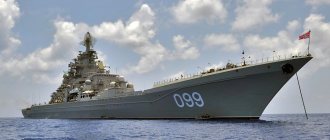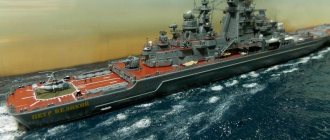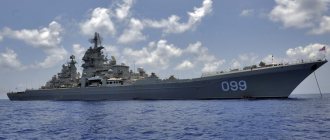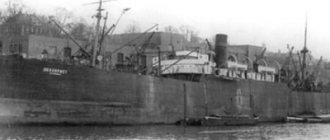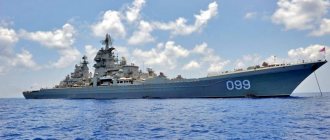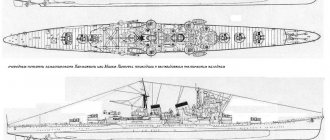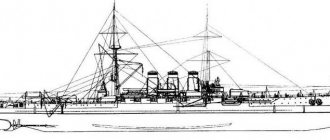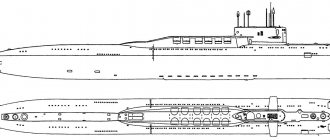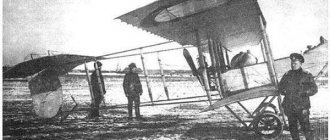3mv.ru
The size of a twenty-story building, a little more than 1/4 km long, the width of half a football field, weighing more than 25 tons, it reaches speeds of up to 59 km/h. This is all about it - the pride of the Russian Navy - the heavy nuclear-powered missile cruiser "Peter the Great".
Great Construction
12 years - during this period the world's largest cruiser was built (with the exception of aircraft carriers), which became the flagship of the Northern Fleet.
The idea of creating ships of gigantic size was born in the 80s. The USSR began to design seven heavy cruisers that could prevent an aircraft strike. And America is “to blame” for everything.
The USA was superior to our country in many ways. Aircraft carriers left American factories one after another, their number numbering in the dozens. As a result, the leadership of the USSR came up with the idea of building means of combating aircraft-carrying cruisers and created Project 1144 “Orlan”. It included the construction of four heavy nuclear-powered missile cruisers:
- "Peter the Great".
- "Admiral Nakhimov".
- "Admiral Ushakov".
- "Admiral Lazarev".
Today, "Peter the Great" is the only operational nuclear-powered cruiser of the Navy.
A uniform
Evolution of the cuirassier uniform
Under Peter I, the uniform of the Russian army underwent a number of changes. Back in 1692, a uniform was approved for the regular guard regiments, completely uniform, with some Western elements based on traditional Russian ones. The main colors became green and red, which was based partly on traditions, and partly on the banal cheapness of green dye in Russia, and the perception of red as the royal color. In 1698-99, while maintaining the same color palette, the uniform was changed towards the uniform of the French army of Louis XIV, and was now introduced for the entire regular army. At the same time, the dragoons received a blue uniform, not green, and the artillerymen always wore red. For the cavalry, the blue uniform was abolished already in 1727, making it green and red, like the infantry. The main headdress remained cocked hats; in winter, caps were used to protect the head, which were handed over to warehouses in the spring. Grenadiers until 1752 wore special grenadier caps, after which they changed their headdresses to Prussian-type grenadier miters. The style of the uniform itself was constantly changing in favor of simplification and following pan-European trends, primarily the Prussian uniform. The biggest change in it was the abandonment of the red color in 1797 - officially to make infantry and dragoons less noticeable to the enemy on the battlefield. In addition to green, white became the main secondary color. Artillerymen began to wear uniforms similar in style and color to the general army uniform. Headdresses also changed - for the infantry from cocked hats to shakos, for the dragoons - to “Hellenic” helmets. At the end of the 1780s, greatcoats were also introduced for the entire army. Garrison regiments and police wore uniforms made of gray undyed cloth [5].
The arrows originally wore a less visible uniform, with all red elements replaced by green or black. Instead of a cocked hat, they wore leather helmets with a crest, but they turned out to be uncomfortable and often completely useless, as a result of which they were replaced with hats, and then with shakos. However, instead of shakos, riflemen often wore lightweight caps, which were sewn from green fabric by the regimental sewing teams. They were much lighter, provided much better ventilation, and besides, they did not interfere with shooting, and the visor also covered the eyes from the sun. However, the use of light caps remained unofficial and depended entirely on the will of the commander - at all reviews and parades, riflemen continued to wear shakos. Plastuns also wore a single uniform, but its style and color were determined by the military administration. Initially, they used a uniform made of gray undyed cloth, as it was cheaper, but over time, gray became their standard color, sometimes with black elements, which is why the Plastuns were also called “gray Cossacks” or “gray soldiers.”
Cossack uniforms were introduced simultaneously with the regular regiments, and were based on their traditional clothing. Initially, it was green-red, like all army uniforms, but in 1784 the colors for some Cossack troops were changed - the Don became blue-red, the Ukrainians, on the contrary, red-blue, and the Urals and Terets completely preferred black. The composition of the uniform itself, de jure the same for all troops, was also constantly changing, and adjustments were made by military administrations, which is why in fact it was possible to distinguish a Cossack of one Cossack army from another by their uniform.
The hussars, unlike European armies, had uniform colors for all regiments, green, red and white, in the main colors of the uniform of most of the army [6] . At the same time, an exception was made for the Guards Hussars, and the main colors of their uniforms became the colors of the state flag [7] . The style of the uniform changed slightly; the biggest change was the transition from high fur hats to shakos. The lancers also had a standardized uniform in color - initially red and white, similar in style to the dragoons, and from 1800 - blue and red, with white trim, which copied the style of the uniform of the Polish lancers. This uniform also included a confederate cap, and was much more expensive than the previous one. Cuirassiers initially wore trousers, tunics and a collar made of white and yellow leggings, with red trim, but due to the high cost, later the same uniform began to be sewn from white thick cloth with black trim. Cuirasses were always painted black. At the beginning of the 19th century, hats were also replaced - from triangular hats with a casket to leather helmets of the “Hellenic” type, with a high crest.
The production of almost all uniforms was carried out in private factories, but strict quality control of the accepted products was carried out. In case of delivery of low-quality uniforms, the state had the right to refuse acceptance and not pay money for the order, which resulted in large losses for private owners. Some of the uniforms were produced at state factories, and at headquarters they were considered to be of higher quality, but in reality everything turned out differently - quite often in exchange for a bribe, or for the sake of supporting state-owned factories, the acceptance department allowed frankly low-quality products that were no good. The most famous example of such actions were leather army helmets, which they tried to adopt in the 1780s - within a year or two of service they became deformed, became unusable, and often fell apart during the first active use, which is why they had to be abandoned . Because of this, government suppliers of uniforms enjoyed a low reputation, and were considered directly by the troops to be less reliable than those produced by private companies.
floating city
The cruiser has 6 decks and 8 tiers. About 20 km of corridors and about 1.5 thousand rooms provide high comfort and habitability of the ship. The crew is approximately 800 people.
spbstu.ru
On board there is:
- baths and saunas;
- showers;
- pool;
- Gym;
- billiard room;
- ship's television studio.
There is also a medical block with isolation hospitals, an operating room, dental and X-ray rooms, an outpatient clinic and a pharmacy. Three elevators help the crew move between floors.
"Peter the Great" can sail for two months without replenishing food supplies. The neutron heart - the cruiser's power plant - consists of two BN nuclear reactors with a total capacity of 600 MW. This power can easily provide energy to a city with a population of up to 150 thousand people. The cruiser's power reserve is unlimited.
Formidable sea fortress
"Peter the Great" will unpleasantly surprise any enemy, since no surface ship in the world has so many weapons on board. A listing of all the weapons available on board the cruiser, along with technical characteristics, will take more than one page. Below are only the key types of available weapons.
army-news.org
"Granit" - "aircraft carrier killer"
These are anti-ship missile systems, the main weapon of the cruiser. Warheads have both conventional and nuclear warheads. They overcome any missile defense system and destroy a target, regardless of its size and degree of protection. They have artificial intelligence: “fire and forget.” The maximum missile range is 700 km.
"Fort-M" - reactive shield
This is an anti-aircraft missile system. Protects the ship from enemy air attacks - airplanes, cruise missiles. The cruiser is equipped with 12 launchers and 96 vertical launch missiles. Can simultaneously fire at 6 targets in the air and accompany 12.
"Dagger" - anti-aircraft missile system
If an enemy missile passes Fort-M, it will be met by the Kinzhal complex. It repels massive enemy missile and bomb attacks in the near zone. 16 drum launchers are hidden below deck. The anti-aircraft complex detects a target at an altitude of 10 m and a distance of up to 45 km.
“Waterfall” – does the “wet job”
This is an anti-submarine torpedo system. Hit enemy submarines at a distance of up to 60 km. The rocket dives into the water, then when a certain depth is reached, the rocket engine is started, the rocket part is separated, which then flies through the air. Having seen the target, the miniature torpedo dives into the water and attacks the enemy.
"Dirk" - "armor" from high-precision weapons
This is a short-range anti-aircraft artillery complex. Provides protection for the ship from precision weapons, boats, and air vehicles. 6 installations are equipped with a six-barreled gun (total rate of fire - 10 thousand rounds per minute) and 8 missiles.
AK-130 – artillery assistant
A tower artillery complex fires at the enemy at sea and on the shore. The shells weigh 27 kg and are equipped with different types of fuses: impact, remote, radio fuses.
"Boa constrictor" - "eater" of missiles
This is a rocket torpedo defense system. Fires projectiles at different distances, thus forming a barrier line and creating false targets. Hidden at the stern of the cruiser are rocket launchers that fire projectiles to kill.
Project history
This is what a battleship would look like if Kostenko built it according to the original real project
The design of the dreadnoughts of the next series after Dmitry Donskoy began in a difficult situation. In 1913, Naval Minister Nevsky died, until the last he held the entire fleet in his hands with an iron grip. It was thanks to him that the fleet did not fall into stagnation and continued to develop, and when he was gone, many became wary - everything depended on the choice of Nevsky’s successor. Such, with the support of Prime Minister Stolypin and Emperor Nicholas II himself, became N. L. Klado, a “student” of Nevsky, one of the leading theorists in Russia and throughout Europe. Although he had a softer manner of doing business, he was an equally advanced and sensible person, constantly analyzing the development of the world's fleets. He, like Nevsky, began to actively intervene in the design of ships, trying to prevent possible confusion in the types of ships and their features. His first major “brainchild” among new buildings was a project named after the great ancestor of the Romanov dynasty - Emperor Peter I the Great.
"Peter the Great" after entering service, Baltic Sea, 1922
Initially, the project was developed under the supervision of I.G. Bubnov, but then work on it was intercepted by another shipbuilder, the “rising star” of the Russian Navy V.P. Kostenko. At the same time, Naval Minister Klado set additional requirements for it - to ensure high speed and a linearly elevated arrangement of the main battery towers. It was recommended to leave four-gun turrets - which made the battleship the world leader in firepower (only the Japanese Yamato can catch up with it in this indicator). Certain problems arose with artillery - the 130/55-mm caliber as a mine countermeasure no longer satisfied the requirements of the sailors, and guns of a larger caliber were simply not at hand. In addition, due to the war with Japan, and then with Germany, the Obukhov plant was inundated with orders, which is why it did not guarantee the timely development and production of 152/50 mm guns. As a result, it was decided to leave the 130 mm cannons on the ship, replacing them with more powerful ones on occasion. Already during completion, a small upgrade was made to the project, and the battleships were able to carry two reconnaissance seaplanes on board. However, a catapult was not provided for them; as a result, to launch, it was necessary to first lower the “bird” into the water with a crane, which in practice resulted in a serious problem and was rarely used.
Construction of the ships began in 1916, at the height of the First World War. Despite the fact that 4 units were laid down, their construction was carried out slowly - all the money was eaten up by the active fleet and army. As a result, in 1918 it was possible to launch only “Peresvet”, in 1919 - “Peter the Great”, and “Gromoboy” - in 1921. “Rurik” remained on the stocks - there was no money for its completion at all. during the war, nor after it, when a wave of pacifism temporarily covered society and the government, and funding for the navy and army was severely cut. Before the Washington Conference, it was possible to complete only one ship - the lead "Peter the Great", and Russian representatives were never able to obtain the right to complete construction of at least one more ship (although in the current conditions they managed to achieve quite favorable conditions) as a battleship, and "Peresvet" and "Gromoboy" had to be rebuilt into aircraft carriers. Thus, "Peter the Great" became the most powerful - and the only one in its series - battleship of the Russian Imperial Navy.
"Peter the Great" after arriving in the Far East, 1924
During the Interbellum, “Peter the Great” became a real “calling card” of the fleet, the pride of the entire country and the mighty “lord of the oceans” - it simply had no equal. Somehow, only the latest American super-dreadnoughts and British Nelsons could reach its level, but they were still inferior to it in salvo weight and speed. The squat, menacing appearance of the Russian ship, four-gun turrets of the main caliber and two high chimneys for a long time became the subject of admiration not only for residents of the Russian Empire, but also for foreigners. “Peter the Great” will have an eventful life - in 1924 it will become the flagship of the Pacific Fleet. in 1929, under the flag of Admiral Kolchak, he would return to the Baltic so that his sailors would take part in the suppression of the March Putsch, which would finally end the long four-year period of political instability in the empire and would place Empress Maria I on the throne instead of the sick Emperor Alexei, who acted as a puppet of his own. advisors. Thus, the battleship will simultaneously become the face of Russia’s renewal, which will once again put the country on the path of rapid development and strengthening. The prestige of the navy and army will return, the armed forces will begin to strengthen - which will allow them to withstand the simultaneous onslaught from the West and the East in a future war. The battleship will undergo a major modernization in 1934-1939 and will once again lead the Pacific Fleet during the battles of World War II, during which it will pass more than one battle with honor. After the war, with the reduction of the fleet, many tried to scrap such a famous ship, but they failed - as a result, “Peter the Great” was installed as a monument ship in Vladivostok, and the state took over the financing of its maintenance. There you can still find this famous ship today (yup, I rolled my lip).
“Peter the Great”, Admiralty Plant, St. Petersburg – 03/15/1916/09/18/1919/1921
“Rurik”, Admiralty Plant, St. Petersburg – 11/21/1916/not completed
“Peresvet”, Baltic Shipyard, St. Petersburg – 03/15/1916/11/20/1918/completed as an aircraft carrier
“Gromoboy”, Baltic Shipyard, St. Petersburg – 04/03/1919/05/18/1921/completed as an aircraft carrier
What I did with Kostenko's real project
Probably the last articles of the load in my practice. The indicated 45,500 tons is the normal displacement of the battleship.
First of all, the armor protection scheme was redesigned. In general, the original design was not the worst, and maybe even very good (personally, I find it difficult to give an assessment, it is painfully non-standard), but on previous battleships I consistently developed and strengthened my more typical armor protection scheme. On the Petra, I strengthened the deck protection to 50+100 mm within the citadel and 25 mm outside it, a 350 mm belt with a 100 mm bow extension and a 200 mm stern extension (there a kind of second citadel is obtained, protecting the rudder drives). The PTZ has been strengthened – it has gained greater depth. The ship's upper belt and anti-fragmentation bulkhead have completely disappeared - in fact, such armor protection is already something like "all or nothing", only with greater attention to protecting the hull at the extremities. In this case, the lower edge of the belt narrows to 200 mm (a feature of the belt of Kostenko’s original design; I simply added millimeters to the outer belt).
Midship "Peter the Great"
The armament remained at the level of the “Dmitry Donskoy” - I saw no point in strengthening or weakening it. The most controversial aspect of the “Peter the Great” is the power plant - the fact is that I took the specific power of the new power plant from the American battle cruiser Lexington - although it is approximately a contemporary of the Peter the Great, it has, for its time, off-scale power with low weight. I don’t know how possible it is to fit something like this into the hull of my ship, but such a power plant was a prerequisite for developing a speed of 28 knots.
Armor protection scheme for "Peter the Great"
